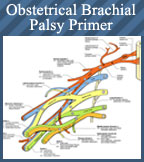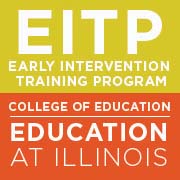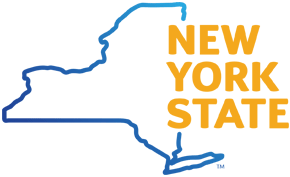Obstetrical Brachial Plexus Injury Primer (OBP) regularly occurs in obstetrical settings throughout the world, at a rate of 1 per 1,000 births, or 370 per day world-wide. These children will all require intervention by an occupational and physical therapist, or hand therapist that requires intense intervention using a broad repertoire of modalities and therapeutic interventions, often as part of a team approach which includes pediatric neurosurgery, pediatric orthopedics, neurologists, and plastic surgeons. Early therapeutic intervention is critical to success.
- Are all Erb’s palsy injury from obstetrical causes, or can they have intrauterine causes?
- What permits the PNS to heal at 2-5 millimeter per month, while the CNS is inhibited from nerve regrowth?
- What beneficial strategy do plexi gain from an intricate design meshwork that sequentially bifurcate and trifurcate, only to rejoin again distally?
- What clinical signs differentiate a pre-ganglionic from post-ganglionic injury?
- What is the differing clinical presentations of Erb's, Klumpke's and total plexus palsy?
- What substitution pattern is therapeutically acceptable with Klumpke's or total plexus injury?
- What are the various causes of scoliosis stemming from OBP?
In this comprehensive didactic primer, therapists will learn and review the answers to these questions, and learn why an upper plexus injury is more likely to recover than a lower plexus lesion as a function of Wallerian degeneration and understand the difference between a preganglionic and post-ganglionic injury.
Learn diverse concepts such as dystocia, macrosomia, spinal rootlets versus roots, motor engram, substitution pattern, flail limb, Erb’s engram, agnosia, cross-innervation, neurotrophic change, compensatory movement, substitution pattern, somatotopic spinal organization, axon reflex, whole plexus palsy, and why a unilateral Moro reflex is diagnostic of Erb’s palsy while unilateral grasp reflex is diagnostic of Klumpke’s palsy. Understand the grading of severity of injury, risk factors such as whether the child’s mother has a gynecoid versus android pelvis, and diagnosis.
Understand the sequela, prognosis, types of surgical intervention, neuroimaging, and role of electrotesting in obstetrical brachial palsy, and learn about the many treatment approaches, including hand-therapy, sensory re-education & awareness training, electrical stimulation, botulinum toxin A injections, splinting and how dynamic splints may assist reinnervation, positioning, stretching, joint mobilization, and other treatment modalities such as the use of electro-testing as a guide to recovery to motor training that maximizes potential neuromuscular recovery.
This wide-ranging and informational primer is a MUST READ for all early intervention and pre-school therapists who service the professional needs of the infant, toddler, and child suffering from obstetrical brachial palsy.
Sign up now!
EITTOC is an approved provided of Continuing Education by the American Occupational Therapy Association, Inc. EITOC is authorized to offer 0.55 AOTA CEU's/5.5 Contact Hours. The assignment of AOTACEU's does not imply endorsement of specific course content, products, or clinical procedures by AOTA.

EITTOC is an AOTA Approved Provider of professional development. Course approval ID# 8922. This distance learning-independent is offered at 0.55 CEUs, introductory, OT service delivery/foundational knowledge. The assignment of AOTA CEUs does not imply endorsement of specific course content, products, or clinical procedures by AOTA or indicate AOTA approval of a certification or other professional recognition.
APPROVED BY THE ILLINOIS EARLY INTERVENTION TRAINING PROGRAM FOR EARLY INTERVENTION CREDENTIAL CREDIT for 5.5 Hours
- Meets NY State (NYSOTA) Continuing Compliancy Requirements for continued Core Competency Hours (CCH) -
- - This activity is pending approval from the National Association of Social Workers (NASW) –
Approved as a Core of Knowledge Training by Office of Childcare: Maryland State Department of Education - *This course meets the basic criteria of the Maryland Board of Physical Therapy Examiners for 0.5 CEU’s. *Ohio Physical Therapists and PTA's are awarded 6.5 hours - 0.65 CEU for this course; Note: The above advertisement is made available to all physcial therapy licensees on a non-discriminatory basis; Approval of this course does not necessarily imply that the WV Board of Physical Therapy supports the views of the presenter or sponsor
Disclosure: David C Saidoff PT - course developer/presenter - has the following relevant financial relationships to disclose: he receives monetary compensation for the preparation of this course, in addition to a percentage of company sales, and has the following relevant non-financial relationships to disclose: EITTOC Board of Directors: volunteer member. Melissa Whelan, OTR - course developer/presenter - has the following relevant financial relationships to disclose: she receives monetary compensation for the preparation of this course, in addition to a percentage of company sales, and has the following relevant non-financial relationships to disclose: EITTOC Board of Directors: volunteer member. Dr. Robert Koppel, M.D., FAAP, Diplomate of the American Board of Pediatrics has the following relevant financial relationships to disclose: he receives monetary compensation for the preparation of this course, in addition to a percentage of company sales, and has the following relevant non-financial relationships to disclose: EITTOC Board of Directors: volunteer member. Declaration: Approval of this course does not necessarily imply that any of the governing bodies (e.g., West Virginian Board of Physical Therapy, or other such governmental or NGO’s supports the views of the presenter or sponsor. Information provided should be used within the scope of practice. No relevant financial or non-financial relationships exists between EITTOC or the products discussed any course; no such relationship or endorsement exists for any products mentioned in any courses sponsored by EITTOC, or in any of the items (such as specific AED or Epinephrine injection product) or any testing instrument used to evaluate children; the above course is specific to said-topic, and may not be extrapolated to any other course or topic outside the scope of this course. Course instructor(s) have no other financial or non-financial remuneration - whether prior to or following course delivery; the above advertisement is made available to all physical therapy (and other) licensee on a non-discriminatory basis. Information provided should be used within scope of practice. AOTA does not endorse specific course content, products, or clinical procedures. The onus of responsibility for this course – granted contact hours by the AOTA – is for each OT professional to check with their State board of OT to see if this course meets licensure requirement for continuing education. |






